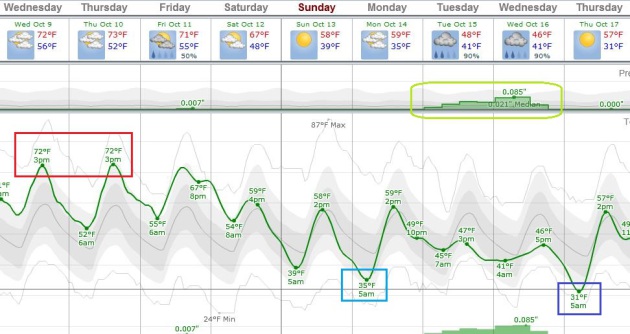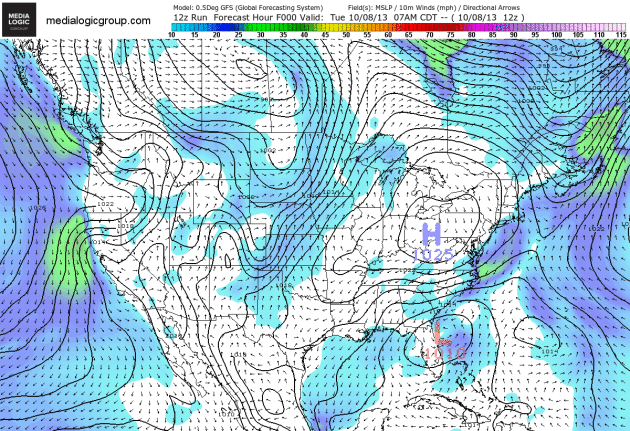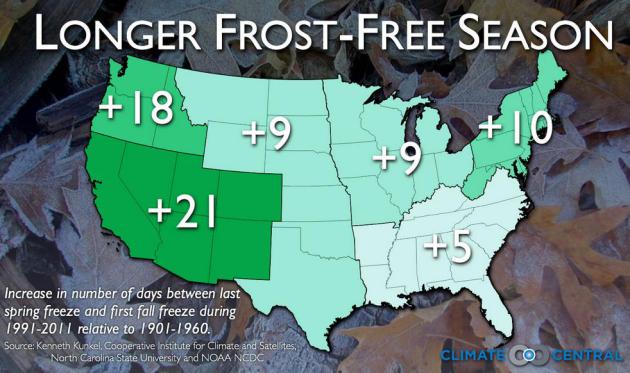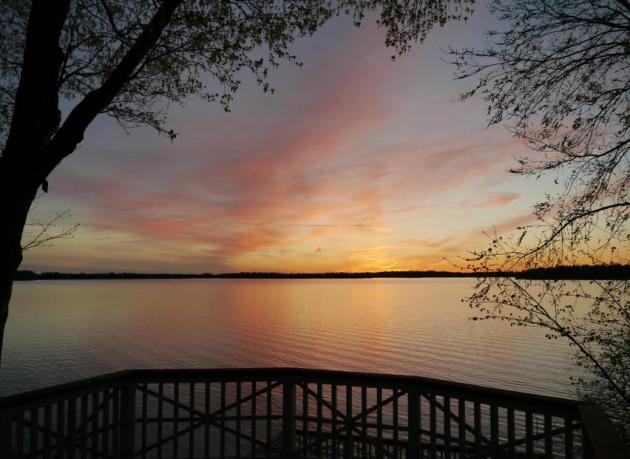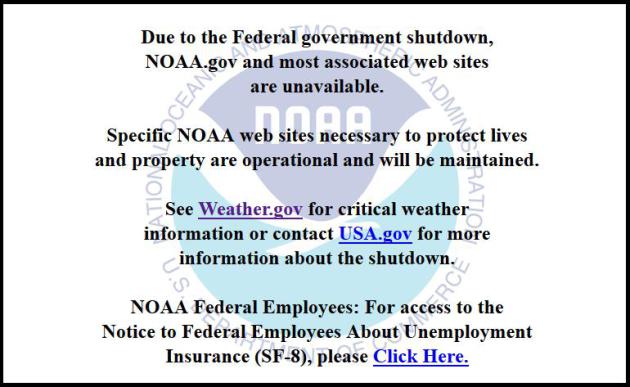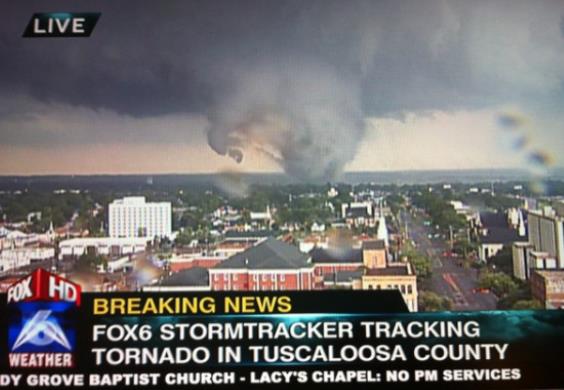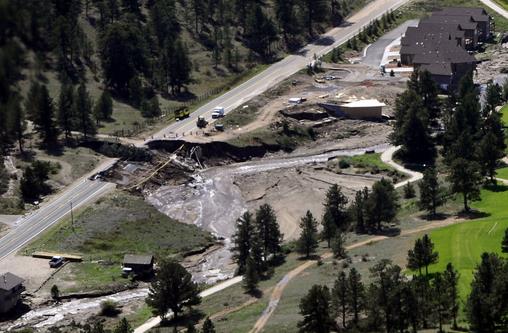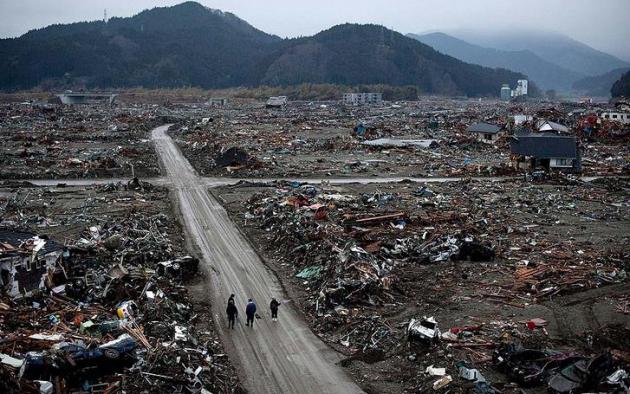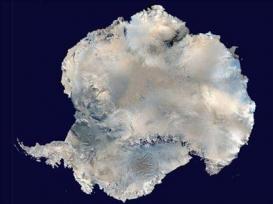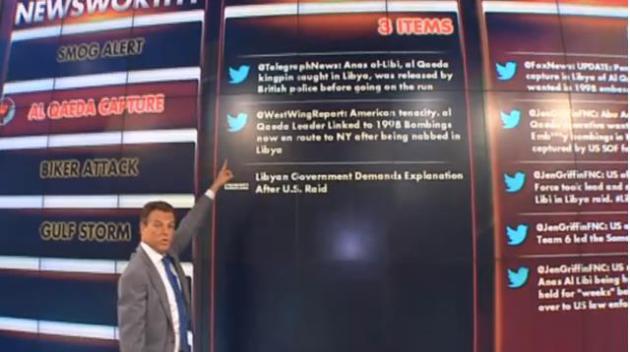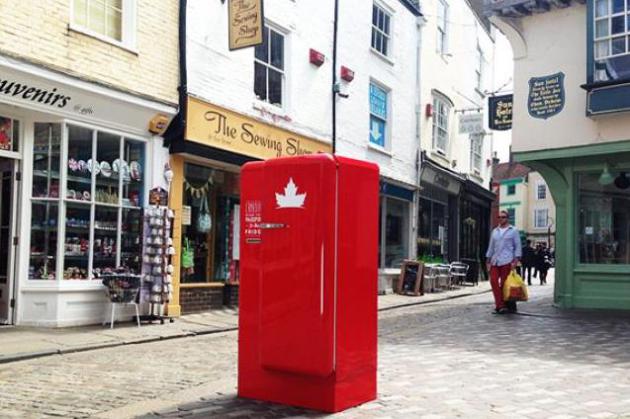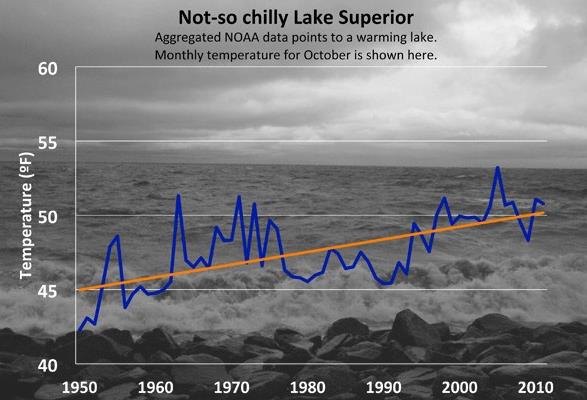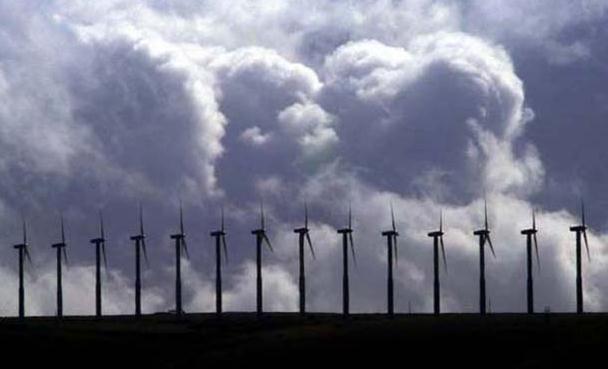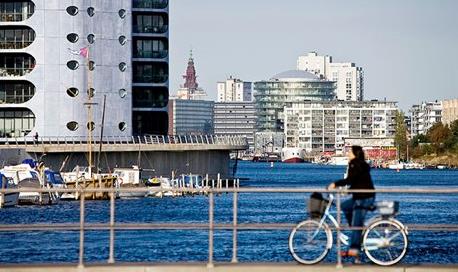Still Frost-Free
According
to NOAA, Minnesota's frost-free season is 9 days longer now than it was
from 1901 to 1960. It's 21 days longer in LA, Phoenix and Salt Lake
City.
A warmer, wetter atmosphere is spiking winter snows as well
as summer T-storms. Tell that to residents of Rapid City, where they
just went from a 3-4 foot blizzard to 70s in 48 hours.<p>On
Tuesday I spoke to the St. Paul Public Works, the men & women who
service 863 miles of streets, 806 miles of sanitary sewers & 60
city-owned bridges.
I showed them the trends: more intense summer
rains, higher summer dewpoints, more midwinter ice & rain and a
potentially longer freeze-thaw cycle that may spawn ever-larger
potholes. One manager approached me after my talk. "We're seeing
evidence of more extremes. It'll be quiet for weeks and then all heck
breaks loose. It makes staffing up almost impossible" he said.
Infrastructure designed in the 20th century will get a work-out in the 21st. Resilience is more than a passing fad.
70s
linger into Friday, when a passing shower marks the arrival of October
reality. Nothing bitter is in sight, but a light frost in the outer
suburbs Monday gives way to steadier rain by Tuesday of next week.
Dear Mr. Douglas,
Again
I want to thank you for your presentation today. I personally feel
your data spoke for itself. Being an agency that responds to the events
mother nature throws our way I can personally say that we have
experienced the greater extremes of the weather events you have
discussed. We will have intense snow storms followed by weeks of
nothing. In 2010-11 season we declared nine snow emergencies contrast
that with 2011-12 where we declared 1. We are also noticing 1”
rainfalls, and occasionally 2”, as becoming more common than in the
past.
As this phenomena continues it will make it harder for our
agency to staff accordingly and meet our resident’s needs. In winter
for example, if we staff to handle the big storms in a reasonable amount
of time It means we will be over staffed for the “drought times”.
Likewise if we staff for the “less snow times” It will take us longer to
dig out of the heavy snows – which most likely brings complaints and
its host of issues as our customers are not as patient as they used to
be when I was growing up. They seem to have forgotten it snows in
Minnesota.
Again thank you for the great presentation. Its News I can use.
John P. Maczko, PE, PTOE
City Engineer
Saint Paul Public Works
* details on Minnesota's first Climate Adaptation Conference coming up on November 9 at the St. Paul Science Museum below.
Mild Into Friday - Then Back To October.
ECMWF guidance above shows a weekend cool-down; 50s returning early
next week, maybe even some 40-degree highs by the middle of next week
with heavier, steadier rain. There's a slight chance of frost Monday
morning, a better chance of frost next Thursday morning. Yes, we're due.
Graph: Weatherspark.
Shifting Gears.
GFS guidance shows another major, full-latitude trough spinning up a
significant storm over the Plains and Upper Midwest (probably no
blizzards or EF-4 tornadoes with this one), but it will tug seasonably
cool air southward by the weekend. Meanwhile a nearly stationary storm
triggers (minor) coastal flooding from the Carolinas northward to New
Jersey. Map above shows predicted 10 meter wind speeds (green =
strongest winds) and surface pressure, courtesy of NOAA and Ham Weather.
Increasingly Frost-Free. This October is a shining example of longer-term trends with Minnesota's growing season. The graphic above, courtesy of
Climate Central, shows a
9 day increase in the growing season between 1991 and 2011, relative to 1901-1960.
9 Extra Frost-Free Days.
There's a fairly compelling data set showing that Minnesota is
experiencing 9 more days of frost-free weather than during the beginning
of the 20th century. Out west, especially the Southwest USA, the number
jumps as high as 21 extra days without frost. Details, and a fall color
update, a look at how milder weather, deeper into autumn may be
impacting photosynthesis and the vibrancy of those peaking fall colors -
all in today's edition of
Climate Matters.
Length Of The Growing Season. The
EPA has more details on America's longer growing season. Here's an excerpt:
*
The average length of the growing season in the contiguous 48 states
has increased by nearly two weeks since the beginning of the 20th
century. A particularly large and steady increase occurred over the last
30 years.
* The length of the growing season has increased more
rapidly in the West than in the East. In the West, the length of the
growing season has increased at the average rate of about 22 days per
century since 1895, compared with a rate of about eight days per century
in the East.
Autumn Falling Back.
No, you're not imagining it. The wicked winds of winter are delayed
(most years). A silver lining for many, but certainly more evidence that
it's not your grandfather's weather pattern any longer. Graph above
courtesy of
Climate Central.
Federal Shutdown Affects Weather Agencies. Here's an excerpt of an article at
The Tribune, serving San Luis Obispo: "
Effects
of the federal government shutdown have extended to weather-related
agencies. The National Weather Service will continue to operate through
the ongoing shutdown. Last week about 4,000 weather service employees
were excepted from the shutdown to support its mission of protecting
life and property. They will continue to issue forecasts and warnings
24-7. The employees don’t know when their next paycheck will arrive,
however. Many of the National Oceanic and Atmospheric Administration
(NOAA) web sites may not be available. For example, if you visit the
National Data Buoy Center webpage, you may get an unavailable message.
The government sequester combined with the shutdown not only is
affecting their websites, but more importantly, also having an impact on
marine buoy preventative maintenance, repair and replacement..."
Climatologist Says Slow Hurricane Season Winding Down.
Too much Saharan dust, too much wind shear, too much dry air. It's a
long laundry-list of meteorological alibis. Here's an excerpt from
Louisiana's
The Advertiser: "
Two-thirds
of the 2013 hurricane season is gone and, so far, no storms have hit
the Louisiana coast. Predictions for an active storm season appear to have been wrong,
says the state climatologist. With conditions in the Gulf of Mexico
becoming less hurricane-friendly, the likelihood of a major storm
hitting the Gulf Coast is decreasing daily, said Barry Keim, an LSU
professor and state climatologist. Gulf waters reached their maximum
temperature Sept. 10, which also is the peak of the storm season, and
have been cooling. But he said he learned long ago, “in the weather
world, never say never...” (Image: NOAA).
Weather Service Sees "Pineapple Express" Winter For Area. In this article at
The Seattle Times
I discovered that NOAA's ocean buoys, which provide essential data for
mariners (and weather models) won't see routine maintenance until 2014,
when budgets are (hopefully) restored, just one more impact of the
government shutdown. Here's an excerpt: "...
In the Northwest, El
Niño winters are often warmer and drier; La Niña winters are typically
colder and wetter. “Neutral” winters in the Puget Sound area are hard to
predict, Buehner said, because the jet stream, directing moisture to
the U.S. West Coast, tends to move over a wide area. “It’s like holding a
hose about four feet back from the end. It tends to wiggle,” he said.
Those winters, Buehner said, are often associated with storms that
arrive in Western Washington carrying an “atmospheric river,” a narrow
band of intensely wet air sometimes called a “Pineapple Express.” The
three-month outlook from the Weather Service’s Climate Prediction Center
calls for above-average temperatures and average precipitation in the
Puget Sound area..."
Study Of April 27, 2011 Tornadoes Affirms Theories About Causes. A story at
Claims Journal caught my eye - here's a clip: "...
A
new study of that outbreak gives forecasters and scientists who study
severe weather detailed meteorological data about what happened that
day, at the same time apparently affirming some new theories about
factors that might enhance tornado development. “The indications are
that gravity waves, topography and surface roughness each played at
least some role that day in creating tornadoes or making them more
powerful,” said Dr. Kevin Knupp, director of the Severe Weather
Institute – Radar and Lightning Laboratories (SWIRLL) at The University
of Alabama in Huntsville (UAH)..."
Flood Forensics: Why Colorado's Floods Were So Destructive. Here's an excerpt from an interesting story at
NPR: "...
If
the soil becomes too wet, mountainsides collapse — and flow downhill.
That's what happened across Colorado's northern Rockies. The floods
started with a wall of moist air from the Gulf of Mexico that got
trapped up against the Mountains, dumping almost a year's worth of rain
in four days. As the overflow coursed through mountain ravines and
canyons, it was like running a fire hydrant through a garden hose. But
it wasn't just water. Streams became rivers of trees, boulders — and an
avalanche of concrete. Farther along the highway, we find thousands of
uprooted trees, dumped in a jumble by a flooded stream. Above the
jumble, the stream bed has been scoured out..."
Photo credit above: "
This
aerial photo shows flood damage in Greeley Colo. during a helicopter
tour by Vice President Joe Biden, Gov. John Hickenlooper, and FEMA
officials, of flood-ravaged areas, Monday, Sept. 23, 2013." (AP Photo/The Denver Post, Kathryn Scott Osler, Pool).
Heat-Expanded Water Blamed For Aggravating 2011 Japanese Tsunami. I'm continually amazed by how much we don't know what we don't know. Here's an excerpt of an interesting post at
RTT News: "
A
research team says that heat-swollen water in ocean bedrock off
northern Japan may have intensified the fault displacements that led to
the devastating 2011 earthquake, increasing the size of the tsunamis.
Earth scientists from ten nations including Japan, the United States and
European countries say water in deep sea bedrock expanded due to
frictional heat caused by the 2011 earthquake. This made the tectonic
plates in the area more slippery, helping to trigger their large-scale
movement. This phenomenon may have increased the size of the tsunami
that followed the tremor, Japan's NHK broadcaster reported on Tuesday
quoting the scientists.."
Photo credit above:
Los Angeles Times.
Read more here: http://www.sanluisobispo.com/2013/10/05/2719236/federal-shutdown-affects-weather.html#storylink=cpy
Rapid City FOX Stations Marooned After Weekend Blizzard. Thank God for Facebook (and snowmobiles).
TVSpy has the remarkable story - here's the intro: "
Staffers at Rapid City, SD, FOX affiliate KEVN found themselves stuck at the station after a snowstorm hit the area over the weekend. The station posted a plea for help to its facebook page yesterday,
“Hey viewers we have a favor to ask! Is there anyone out there in Rapid
City with a snowmobile that could help us out? We have been stranded at
the station for days and desperately need to replenish the crew....”
We've Seen Frontline's Highly Anticipated Concussion Documentary, And It Is Very Bad For The NFL. Here's an excerpt from
Buzzfeed: "
As you watch League of Denial,
the two-hour Frontline investigation premiering tomorrow night on PBS —
as you watch its subjects, the men running the NFL, evolve from private
ignorance to public dishonesty on the issue of concussions — you may at
some point realize that a story about brain trauma has left you
involuntarily shaking your own head. Eighteen months in the making,
League of Denial is a triumph of investigative journalism into one of
the most pressing public health crises of our time. It was only six
weeks ago that ESPN, which had been a high-profile collaborator on
League of Denial for the better part of a year, severed all ties with Frontline, citing a lack of editorial control..."
* ESPN has more on what the NFL knew about the concussion risk, and when they knew it
here.
A Must-Watch Documentary.
PBS Frontline is one of the last bastions of consistently great TV
journalism these days, and they've upped the ante considerably with
their latest subject, concussions and football safety, not only in the
NFL, but among kids.
The program
goes nearly 2 hours, but the stories are powerful and compelling.
Disclaimer: I'm a football fan. I don't want any of this to be true. But
the data is the data and we probably need to keep our eyes wide open about
the long-term risks. Sound familiar?
What's The Time In Antarctica? The answer may be harder to compute that you might imagine. Here's a clip from a story at
The Economist: "
Times zones
sometimes have as much to do with politics as geography. Nepal
pointedly runs 15 minutes ahead of its neighbour India. Cross the border
from Nepal into Tibet and you have to put your watch forward by
two-and-a-quarter hours, because China, which really spans five time
zones, operates a single time across the land. At the other extreme,
Russia has nine contiguous time zones, more than any other country.
Until a few years ago it had 11. The problem of the poles applies just
as much to the north as to the south, of course. But no one actually
lives at the North Pole, which lies in the shifting ice of the Arctic
Ocean. Antarctica, by contrast, is home to a small population of
scientists, who need to keep track of time—especially during the
non-stop daylight of summer and through winter’s endless night..."
Peak Soil: Why Nutrition Is Disappearing From Our Food.
So you're telling me I could live to be 100 if the soil provided more
nutrition? What do I do with THAT information? Details from
The Week; here's a clip: "
The
fountain of youth may be made of dirt. So supposes Steve Solomon in The
Intelligent Gardner: Growing Nutrient-Dense Food. He asserts that most
people could "live past age 100, die with all their original teeth, up
to their final weeks, and this could all happen if only we fertilize all
our food crops differently." It's a bold statement, but mounting
evidence suggests that remineralization could be the definitive solution
to our nutrient-light diet. Concerns about the quality of our food tend
to focus on the many evils of modern industrial farming,
but 10,000 years of agriculture have created a more insidious problem.
The minerals and phytonutrients historically derived from rich soil are diminishing in our produce and meat..." (Photo: AP).
Television News Graphics For The Visually Impaired. Good idea or gimmick? Here's an excerpt from
TechCrunch: "
And in this week’s episode of absolutely bizarre behavior from Fox News,
we bring you BATS, officially known as big area touchscreens. The media
outlet responsible for bringing fair and balanced news into our lives
has today released a video that shows off the network’s brand-new Fox
News Deck studio, a room filled with video walls and giant 55-inch
touchscreens that will henceforth deliver the news to Fox News viewers,
along with Shepard Smith. Why, you ask? To deal with “the new reality”
as Senior Executive Producer Kim Rosenberg puts it, which includes
“smartphones, apps, the internet, your computer.” As viewers change, so
too must Fox News, and the only way to deal with the constant presence
of the Internet is to build it right into the studio..."
Meet The Beer Fridge That Opens Only For Canadians. Time to get a Canadian passport. Then again... This is one of my favorite stories of the week;
Mental Floss has the breaking news; here's a clip: "
Next
time you backpack Europe, it may be a good idea to take along your
closest Canadian friend. You just might end up with all the free beer
you’d ever want. To bolster national pride, Canadian beer company Molson
placed beer fridges across Europe, from the streets of London and
Brussels to the pastures of Belgium. Inside those fire engine red
fridges? A free stockpile of Canadian suds. (Instead of planning a pub
crawl through Europe, might we suggest a fridge crawl?) A public fridge
chock full of free beer may sound like heaven to some, but there’s a
problem: It’s locked. And there’s only one way to open it—you have be
Canadian..."
Photo credit above: molsoncanadian.ca
* photo above: Chris Terzich, taken near Eau Claire, Wisconsin.
Climate Stories...
Warming Lake Superior Prompts A Tribe To Try A New Fish.
Arctic ice, glaciers and even large lakes are a good barometer of
long-term temperature trends. Here's an eyebrow-raising article at
The Daily Climate: "...
The lake is warming faster than the atmosphere, said Jim Kitchell, a professor at the University of Wisconsin, Madison, and senior author of a new study
examining the lake's fish. "Lake Michigan and Huron are warming but at
half the rate [of Superior]." Over the past 40 years, the large, deep
freshwater lake has had an average water temperature increase of about 5
degrees Fahrenheit, partly due to a 50 percent ice cover reduction over
the same time. Such changes have increased suitable living areas for
walleye by 223 square miles, one-and-a-half times the footprint of the
city of Detroit. Chinook salmon and lean lake trout have seen habitat
increase by 191 and 161 square miles, respectively, according to the
study from Kitchell and colleagues..."
Preparing Minnesota for Climate Change: A Conference on Climate Adaptation.
This daylong event is being held Thursday, November 7, 2013 9 am - 5:30
pm, followed by a reception at The Science Museum of Minnesota in St.
Paul. This is the first annual gathering of local and state experts
covering a diverse range of topics related to climate mitigation and
adaptation in Minnesota, and some tickets are still available. I'll be
there; if you're personally interested in this topic, or have an
interest in possible impacts on your business or public sector duties in
the years ahead you should plan on attending. Here's a good overview
from the organizer of the event, Dr. Mark Seeley: "
The first ever
statewide conference on climate change adaptation practices will take
place at the Science Museum in downtown St Paul on November 7, 2013 from
9:00 am to 5:30 pm. The cost for the conference is modest at $60 and
includes lunch, breaks, parking, and a free pass to the Science Museum.
This conference which is titled “Preparing Minnesota for Climate Change:
A Conference on Climate Adaptation” has been designed by those who have
been measuring and documenting the changing climate attributes in the
state and their associated consequences. Professionals who have worked
in transportation, agriculture, energy, health care, city planning,
watershed and forest management, and the insurance industry will share
their stories and experiences relative to adapting to our changing
climate. The educational sessions will be followed by an evening
reception in the Science Museum cafeteria at 5:30 pm so that informal
socializing and networking among citizens and groups can occur." If interested in attending you can visit the web site for the conference at
www.wrc.umn.edu
Can The Insurance Industry Weather Climate Change?
The data is the data, and there are few climate change agnostics in the
trenches of the world's major insurance companies. They can SEE what's
happening with storm-related claims. Any doubts will soon be erased as
our insurance premiums rise to keep some of these big companies afloat.
Here's a clip from a story at
LinkedIn: "...
These
things hit insurers hard. Zurich Insurance Group, the biggest Swiss
insurer, downgraded its revenue targets after "natural catastrophe
losses cut second-quarter profit by 27 percent," reported Insurance Journal
in August. And it's not just hurricanes. Strong thunderstorms and rain
across the greater Toronto metropolitan region in July caused
significant flooding and power outages to the tune of US$1.41 billion,
about half of which was covered by insurance, according to The Royal Gazette.
"Nowhere in the world is the rising number of annual natural
catastrophes more evident than in North America," according to Severe
Weather in North America, a 2012 report (download)
published by reinsurance giant Munich Re, which insures other insurers,
thereby limiting the loss any single insurer would experience in case
of disaster. "This increase is entirely attributable to weather events,
as there has been a negative trend for geophysical events..."
New Finding Shows That Climate Change Can Happen In A Geological Instant.
Rutgers University has a new study out that made me do a triple-take; here's an excerpt: "
Rapid”
and “instantaneous” are words geologists don’t use very often. But
Rutgers geologists use these exact terms to describe a climate shift
that occurred 55 million years ago.In a new paper in the Proceedings of the National Academy of Sciences,
Morgan Schaller and James Wright contend that following a doubling in
carbon dioxide levels, the surface of the ocean turned acidic over a
period of weeks or months and global temperatures rose by 5 degrees
centigrade – all in the space of about 13 years. Scientists previously
thought this process happened over 10,000 years..."
* the actual paper (fairly technical but fascinating) is
here, courtesy of The Proceedings of the National Academy of Sciences.
How Carbon Became Political Kryptonite In Virginia's Gubernatorial Election. ThinkProgress has an update; here's the introduction: "
Terry
McAuliffe and Ken Cuccinelli have been battling for control of
Virginia’s Executive Mansion all year. It’s not often that energy and
climate change play a significant role in gubernatorial races but if
it’s true anywhere, it’s certainly true here. A new report
on the consequences of Cuccinelli’s climate denial, brand-new polling
on the race, and an interview with Climate Progress make clear that
refusing to do anything about carbon pollution could be political
kryptonite, while embracing alternative energy and mainstream climate
science could lead to electoral success..."
Photo credit above: AP Photo/The Washington Post, Linda Davidson, Pool.
Toppling Climate Change Investment Myths. Here's a clip from a story focused on climate trends and investment objectives, courtesy of
greentechmedia: "...
So
what does this mean for the financial community? Institutional
investors who are inclined to be cynical about climate change are
probably picking the wrong answers to five key questions.
First, isn’t the science too uncertain to act?
No. Over the past five years, the scientific consensus has concluded
resolutely that human emissions of greenhouse gases are heating the
planet and will continue to do so. There is uncertainty over the rate of
warming and the effect of feedback mechanisms, especially clouds, so
future climate and weather conditions can only be thought of in terms of
potential scenarios. Yet investors are trained to make decisions around
a range of outcomes..." (Photo credit above: AP).
Tackling Climate Change: Copenhagen's Sustainable City Design.
You'll be hearing more about sustainability and resilience in the years
to come. Copehagen is doing many things right, as described in this
excerpt from
The Guardian: "...
And
those convex streets? They are main thoroughfares designed by
Copenhagen's city planners to capture water from storms and flooding and
direct it to the harbour. Copenhagen in 2050 will also feature smaller
streets with plenty of trees, which will slow anticipated flooding "so
not everything comes bursting into the cloudburst boulevards at the same
time", Leonardsen explains. Pocket parks will absorb heat and can be
turned into water storage during weather emergencies. In addition to
storms, flooding and rising sea levels, heatwaves are the most dramatic
scenario facing cities as climate change worsens..."
Photo credit above: "
Copenhagen faces particular danger as sea levels rise and superstorms hit coastal areas with greater frequency." Photograph: Kontraframe.
Climate Fact: Arctic Sea Ice Is Shrinking, Antarctic Sea Ice Is Growing. Why? EarthGauge has the story - here's a snippet: "
The
Arctic and Antarctic sea ice expands and contracts with the seasons:
melting occurs during summer and expansion occurs during winter. The
Arctic reaches its minimum extent in September at the end of summer in
the Northern Hemisphere. On the other hand, the Antarctic sea ice
reaches its greatest extent in September at the end of winter in the
Southern Hemisphere. The Arctic and Antarctic are very different
geographically. The Arctic is surrounded almost entirely by land (North
America, Greenland and Eurasia), which traps most of the sea ice in the
Arctic Ocean and allows multiyear ice to develop. Antarctic sea ice is
bounded to the south by the Antarctic continent and completely exposed
to the Southern Ocean to the north, which allows sea ice to expand in
the winter but does not offer much protection during the melt season.
This means that there is little multiyear sea ice in the Antarctic and
most of the sea ice melts during the summer season..."

